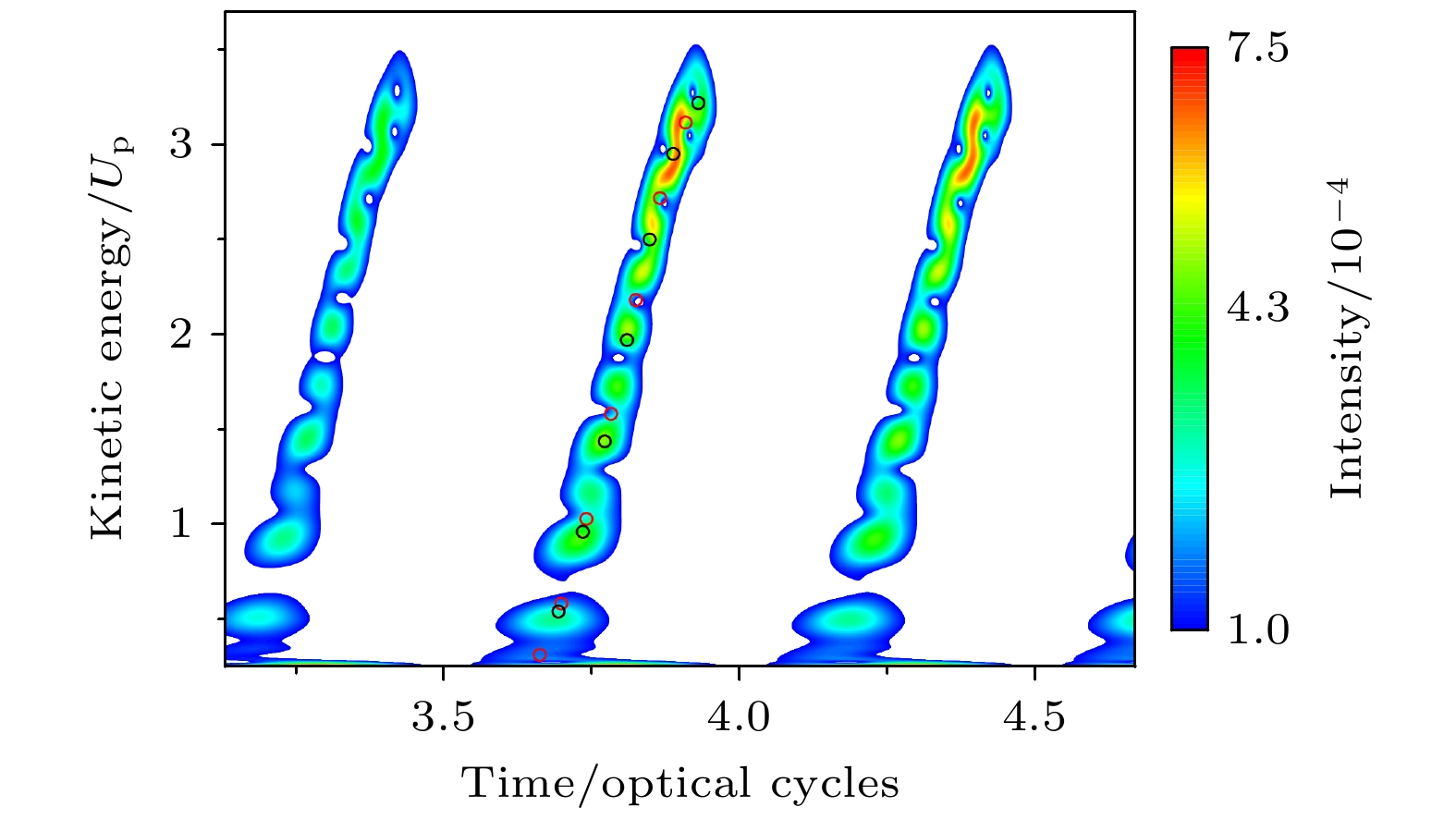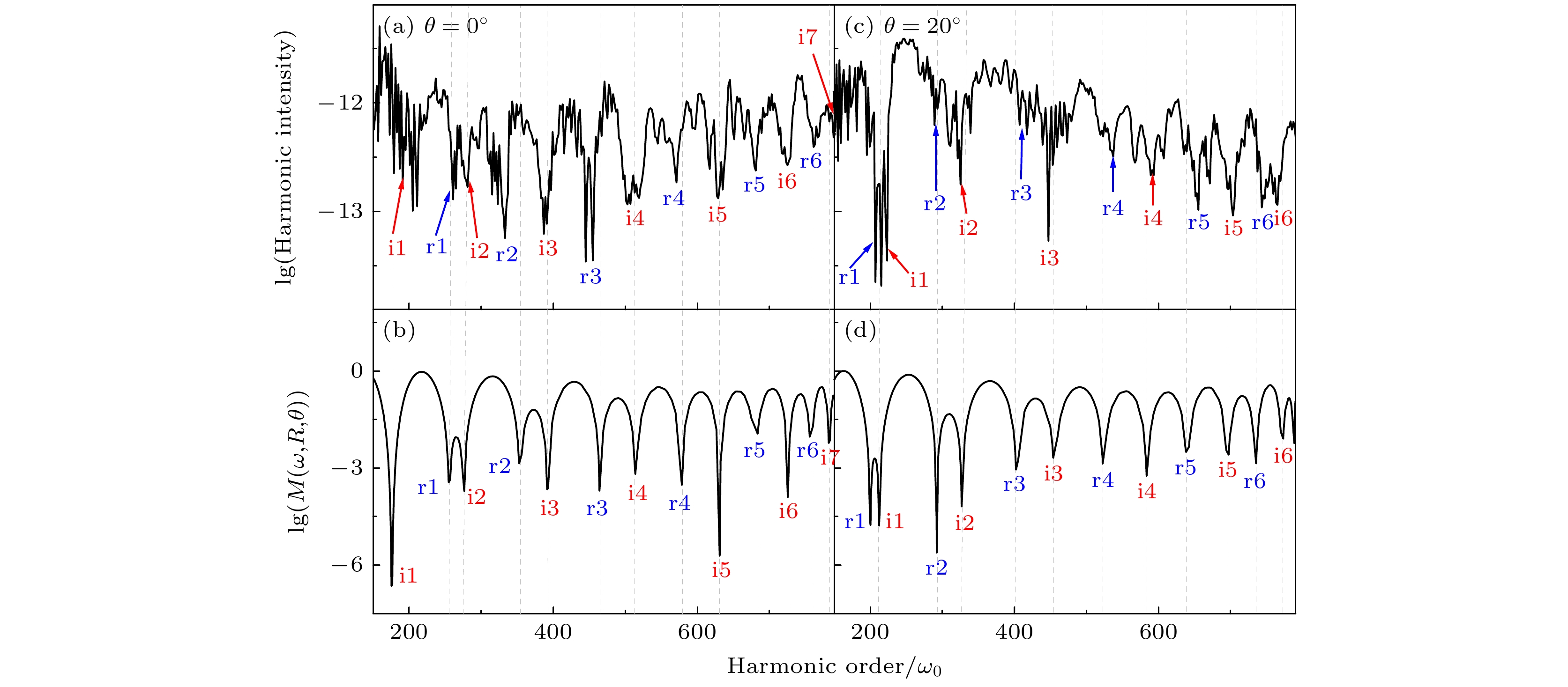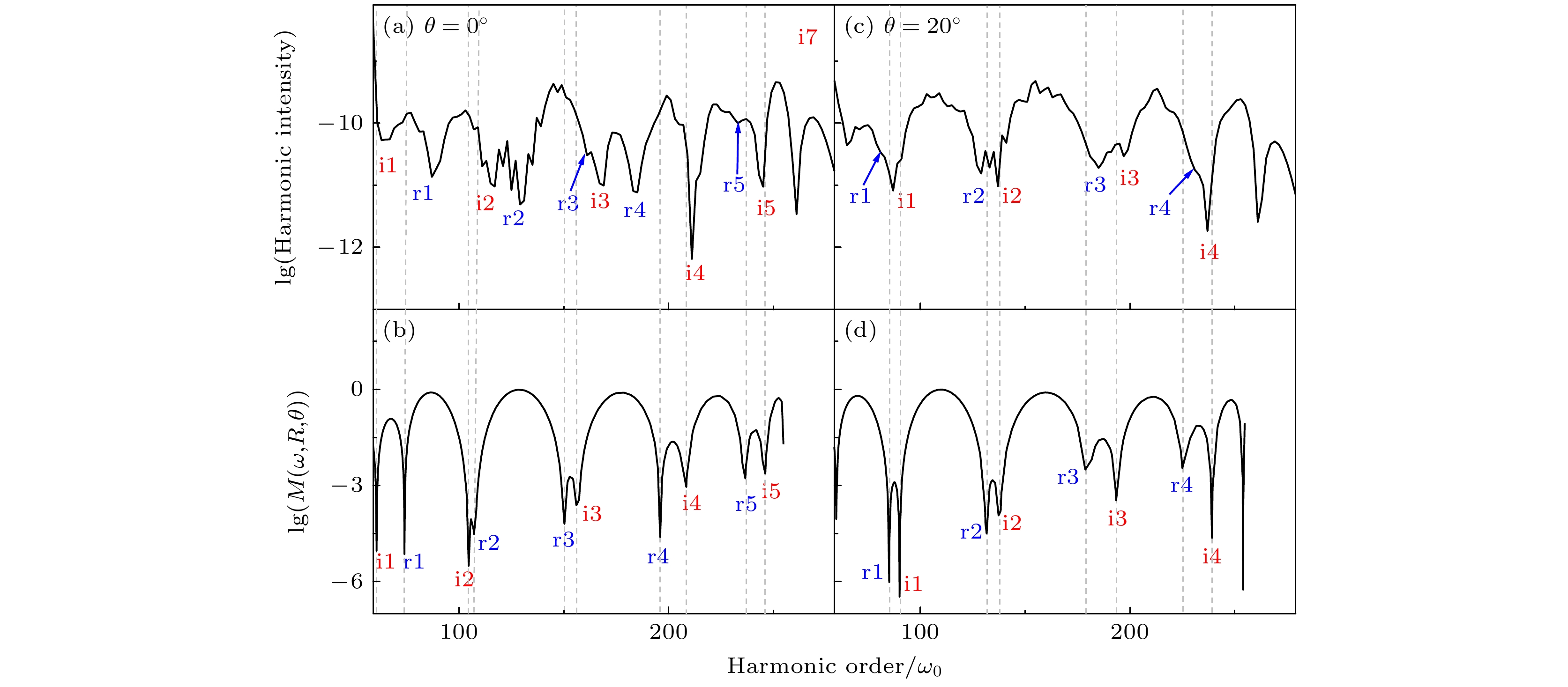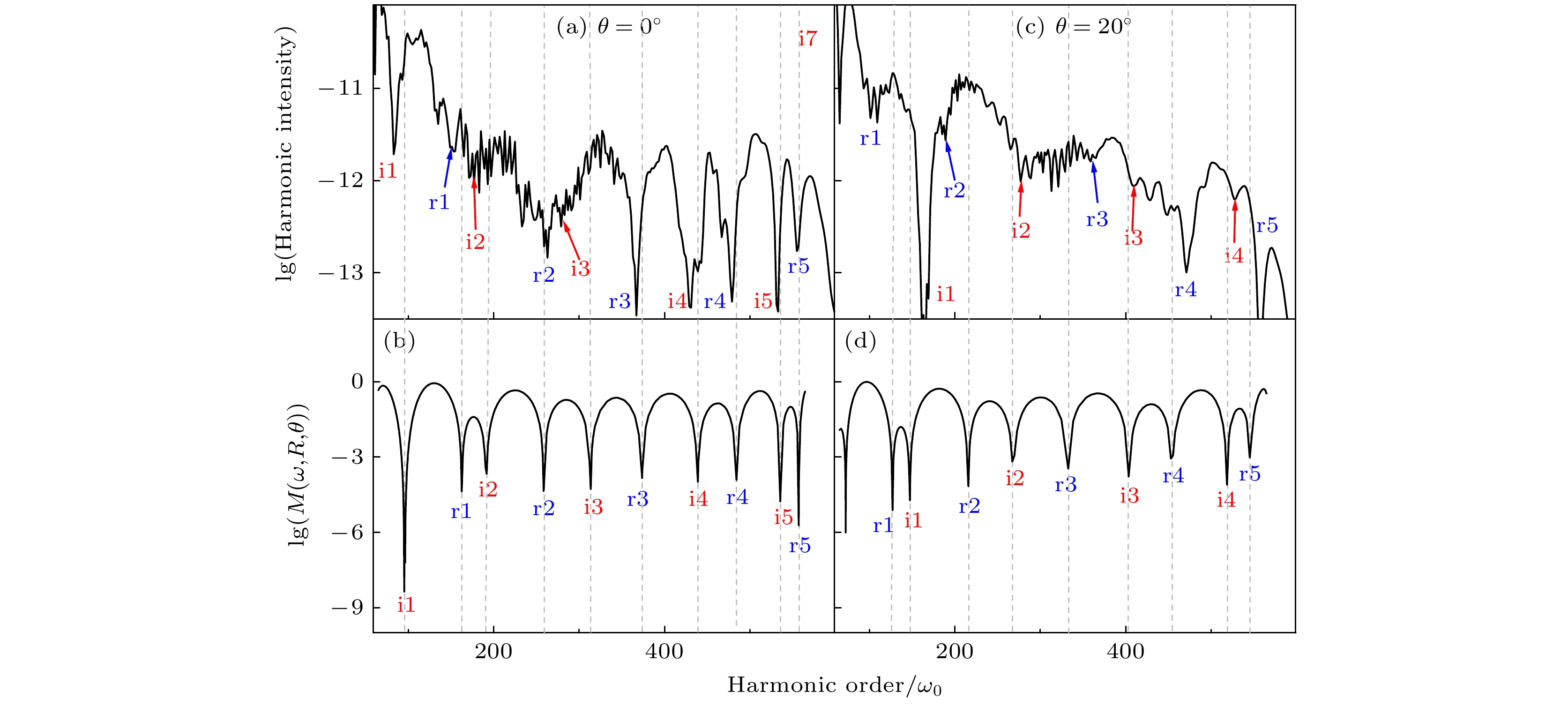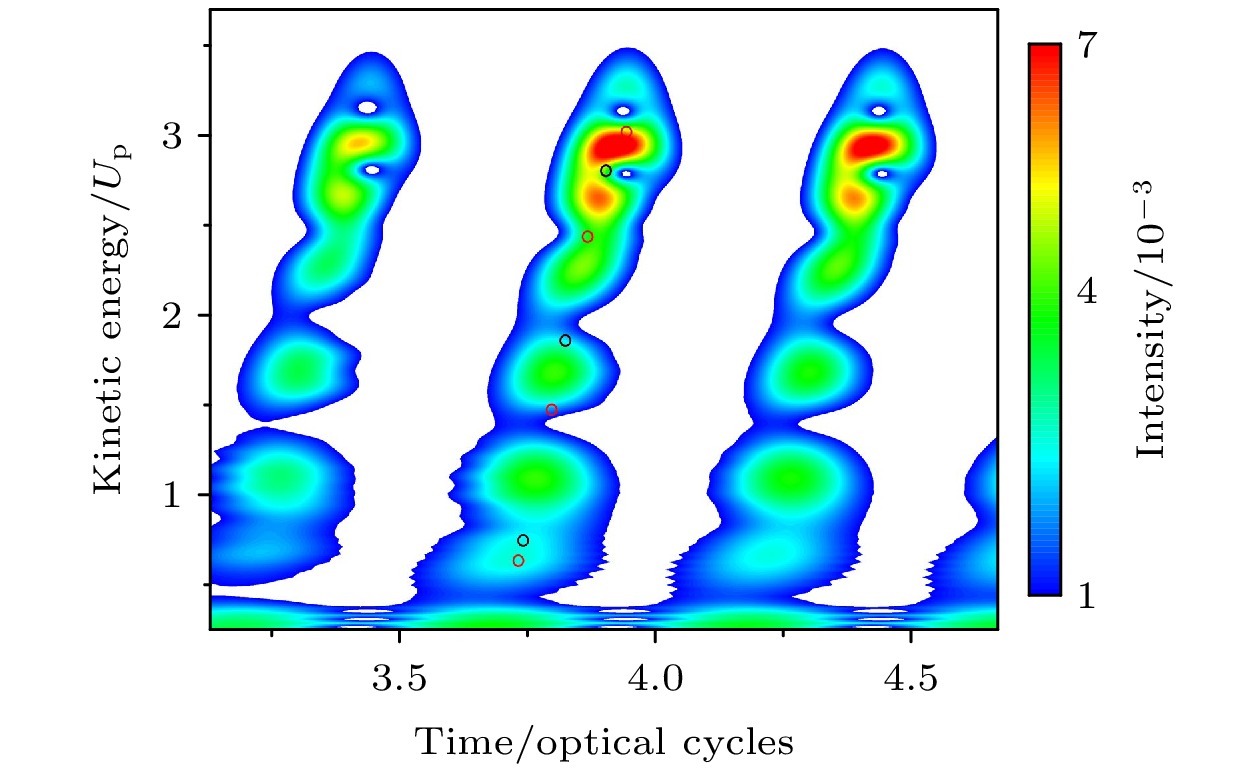-
通过数值和解析的方法研究了拉伸到大核间距的分子离子的高次谐波辐射, 重点研究了与短轨道贡献相关的谐波辐射谱的精细结构. 研究结果表明, 大核间距分子离子的短轨道谐波辐射谱呈现了复杂的干涉结构. 通过利用一个考虑了电荷共振效应的强场近似模型, 可以分辨这些复杂的干涉结构的物理起源: 谐波辐射谱上一些干涉最小来源于电离过程中的两中心干涉效应, 而另外一些干涉最小来源于再结合过程中的两中心干涉效应, 电离干涉最小与再结合干涉最小交替出现. 与电离过程不同, 再结合过程中, 库仑加速会显著改变再结合电子的德布罗意波长, 从而改变干涉最小的位置.High-order harmonic generation (HHG) from the molecular ions stretched to large internuclear distances is studied numerically and analytically in this work. We focus on the fine structure of the HHG spectrum related to the contribution of short electron trajectory. In our numerically solving the time-dependent Schrodinger equation (TDSE), we use a trajectory-dependent filtering procedure to separate the short-trajectory contribution from other contributions of long trajectory and multiple returns. Our TDSE results reveal that the short-trajectory HHG spectra of molecular ion with larger internuclear distance show some complex interference structures characterized by some remarkable dips, and that the position of the dip is sensitive to the laser parameters. With a developed model arising from strong-field approximation (SFA), we are able to identify the physical origins of the complex interference structures. In this model considered is the charge-resonance effect which induces the strong coupling between the ground state and the first excited state of the molecular ion at large internuclear distance. In this model, the well-known effect of two-center interference occurs in the form of the canonical momentum instead of the momentum related to the instantaneous velocity of the electron in the general SFA. It is shown that some dips in TDSE results arise from two-center interference of the electronic wave between these two atomic cores of the molecule in the ionization process, while others come from that in the recombination process. These ionization and recombination dips alternately appear in the HHG spectra from the formed complex interference structures. The main differences between the interference effects in the ionization process and the recombination process are twofold. Firstly, in the ionization process, the destructive two-center interference strongly suppresses the forming of the continuum wavepacket, while in the recombination process, the recombination of the rescattering electron with other bound eigenstates with small weights can also contribute to HHG bedsides the recombination of the ground state with the first excited state with large weights. As a result, in TDSE results, the ionization dips are deeper and more remarkable than the recombination ones. Secondly, in the recombination process, the Coulomb acceleration remarkably changes the de Broglie wavelength of the rescattering electron and therefore changes the position of the interference-induced dip. While in the ionization process, the Coulomb potential plays a small role in the interference effect. As a result, the interference dips in the ionization process and the recombination process differ from each other.
-
Keywords:
- high-order harmonic generation /
- stretched molecular ions /
- two-center interference /
- charge resonance effects
[1] Corkum P B, Krausz F 2007 Nat. Phys. 3 381
 Google Scholar
Google Scholar
[2] Tao Z, Chen C, Szilvasi T, Keller M, Mavrikakis M, Kapteyn H, Murnane M 2016 Science 353 62
 Google Scholar
Google Scholar
[3] Neutze R, Wouts R, van der Spoel D, Weckert E, Hajdu J 2000 Nature 406 752
 Google Scholar
Google Scholar
[4] Hentschel M, Kienberger R, Spielmann Ch, Reider G A, Milosevic N, Brabec T, Corkum P, Heinzmann U, Drescher M, Krausz F 2001 Nature 414 509
 Google Scholar
Google Scholar
[5] Ihee H, Lobastov V A, Gomez U M, Goodson B M, Srinivasan R, Ruan C Y, Zewail A H 2001 Science 291 458
 Google Scholar
Google Scholar
[6] Baltuska A, Udem Th, Uiberacker M, Hentschel M, Goulielmakis E, Gohle Ch, Holzwarth R, Yakovlev V S, Scrinzi A, Hänsch T W, Krausz F 2003 Nature 421 611
 Google Scholar
Google Scholar
[7] Eckle P, Smolarski M, Schlup F, Biegert J, Staudte A, Schöffler M, Muller H G, Dörner R, Keller U 2008 Nat. Phys. 4 565
 Google Scholar
Google Scholar
[8] Corkum P B 1993 Phys. Rev. Lett. 71 1994
 Google Scholar
Google Scholar
[9] Itatani J, Zeidler D, Levesque J, Spanner M, Villeneuve D M, Corkum P B 2005 Phys. Rev. Lett. 94 123902
 Google Scholar
Google Scholar
[10] Le V H, Le A T, Xie R H, Lin C D 2007 Phys. Rev. A 76 013414
 Google Scholar
Google Scholar
[11] McFarland B K, Farrell J P, Bucksbaum P H, Gühr M 2008 Science 322 1232
 Google Scholar
Google Scholar
[12] Shafir D, Mairesse Y, Villeneuve D M, Corkum P B, Dudovich N 2009 Nat. Phys. 5 412
 Google Scholar
Google Scholar
[13] Vozzi C, Negro M, Calegari F, Sansone G, Nisoli M, De Silvestri S, Stagira S 2011 Nat. Phys. 7 822
 Google Scholar
Google Scholar
[14] Lein M, Hay N, Velotta R, Marangos J R, Knight P L 2002 Phys. Rev. Lett. 88 183903
 Google Scholar
Google Scholar
[15] Kanai T, Minemoto S, Sakai H 2005 Nature 435 470
 Google Scholar
Google Scholar
[16] Vozzi C, Calegari F, Benedetti E, Caumes J P, Sansone G, Stagira S, Nisoli M, Torres R, Heesel E, Kajumba N, Marangos J P, Altucci C, Velotta R 2005 Phys. Rev. Lett. 95 153902
 Google Scholar
Google Scholar
[17] Chen Y J, Liu J, Hu Bambi 2009 J. Chem. Phys. 130 044311
 Google Scholar
Google Scholar
[18] Smirnova O, Mairesse Y, Patchkovskii S, Dudovich N, Villeneuve D, Corkum P, Ivanov M Yu 2009 Nature 460 972
 Google Scholar
Google Scholar
[19] Wörner H J, Bertrand J B, Kartashov D V, Corkum P B, Villeneuve D M 2010 Nature 466 604
 Google Scholar
Google Scholar
[20] Salières P, Maquet A, Haessler S, Caillat J, Taïeb R 2012 Rep. Prog. Phys. 75 062401
 Google Scholar
Google Scholar
[21] Lépine M, Ivanov M Yu, Vrakking M J J 2014 Nat. Photon. 8 195
 Google Scholar
Google Scholar
[22] Shafir D, Soifer H, Bruner B D, Dagan M, Mairesse Y, Patchkovskii S, Ivanov M Yu, Smirnova O, Dudovich N 2012 Nature 485 343
 Google Scholar
Google Scholar
[23] Zhao J, Lein M 2013 Phys. Rev. Lett. 111 043901
 Google Scholar
Google Scholar
[24] Etches A, Madsen L B 2010 J. Phys. B 43 155602
 Google Scholar
Google Scholar
[25] Frumker E, Kajumba N, Bertrand J B, Wörner H J, Hebeisen C T, Hockett P, Spanner M, Patchkovskii S, Paulus G G, Villeneuve D M, Naumov A, Corkum P B 2012 Phys. Rev. Lett. 109 233904
 Google Scholar
Google Scholar
[26] Kraus P M, Rupenyan A, Wörner H J 2012 Phys. Rev. Lett. 109 233903
 Google Scholar
Google Scholar
[27] Kraus P M, Baykusheva D, Wörner H J 2014 Phys. Rev. Lett. 113 023001
 Google Scholar
Google Scholar
[28] Lewenstein M, Balcou Ph, Ivanov M Yu, L’Huillier A, Corkum P B 1994 Phys. Rev. A 49 2117
 Google Scholar
Google Scholar
[29] Zuo T, Bandrauk A D 1995 Phys. Rev. A 52 R2511
 Google Scholar
Google Scholar
[30] Becker W, Chen J, Chen S G, Milošević D B 2007 Phys. Rev. A 76 033403
 Google Scholar
Google Scholar
[31] Chen Y J, Zhang B 2012 J. Phys. B 45 215601
 Google Scholar
Google Scholar
[32] Zuo T, Chelkowski S, Bandrauk A D 1993 Phys. Rev. A 48 3837
 Google Scholar
Google Scholar
[33] Ivanov M Yu, Corkum P B 1993 Phys. Rev. A 48 580
 Google Scholar
Google Scholar
[34] Chen Y J, Chen J, Liu J 2006 Phys. Rev. A 74 063405
 Google Scholar
Google Scholar
[35] Chen J, Chen S G 2007 Phys. Rev. A 75 041402(R
 Google Scholar
Google Scholar
[36] Li W Y, Dong F L, Yu S J, Wang S, Yang S P, Chen Y J 2015 Opt. Express 23 31010
 Google Scholar
Google Scholar
[37] Li W Y, Wang S, Shi Y Z, Yang S P, Chen Y J 2017 J. Phys. B 50 085003
 Google Scholar
Google Scholar
[38] Feit M D, Fleck J A, Jr., Steiger A 1982 J. Comput. Phys. 47 412
 Google Scholar
Google Scholar
[39] Milošević D B 2006 Phys. Rev. A 74 063404
 Google Scholar
Google Scholar
[40] Lewenstein M, Salières P, L’Huillier A 1995 Phys. Rev. A 52 4747
 Google Scholar
Google Scholar
[41] Chen Y J, Hu B 2009 J. Chem. Phys. 131 244109
 Google Scholar
Google Scholar
[42] Mulliken R S 1939 J. Chem. Phys. 7 20
 Google Scholar
Google Scholar
[43] Lein M 2005 Phys. Rev. A 72 053816
 Google Scholar
Google Scholar
[44] Chen Y J, Hu Bambi 2010 Phys. Rev. A 81 013411
 Google Scholar
Google Scholar
[45] Cohen Howard D, Fano U 1966 Phys. Rev. 150 30
 Google Scholar
Google Scholar
[46] Zuo T, Bandrauk A D, Corkum P B 1996 Chem. Phys. Lett. 259 313
 Google Scholar
Google Scholar
[47] Yang W F, Sheng Z H, Feng X P, Wu M L, Chen Z J, Song X D 2014 Opt. Express 22 2519
 Google Scholar
Google Scholar
[48] Li Y, Qin M Y, Zhu X S, Zhang Q B, Lan P F, Lu P X 2015 Opt. Express 23 10687
 Google Scholar
Google Scholar
[49] Grundmann S, Trabert D, Fehre K, Strenger N, Pier A, Kaiser L, Kircher M, Weller M, Eckart S, Schmidt L, Trinter F, Jahnke T, Schöffler-Markus S, Dörne R 2020 Science 370 339
 Google Scholar
Google Scholar
[50] Gao F, ChenY J, Xin G G, Liu J, and Fu L B 2017 Phys. Rev. A 96 063414
 Google Scholar
Google Scholar
[51] Ren D X, Wang S, Chen C, Li X K, Yu X T, Zhao X N, Ma P, Wang C C, Luo S Z, Chen Y J, Ding D J 2022 J. Phys. B 55 175101
 Google Scholar
Google Scholar
-
图 1
$R = 16$ 的H$_2^ + $ 的短轨道TDSE谐波谱与模型预测结果, 激光场强度$ I = 5 \times {10^{14}}{\kern 1 pt} {\kern 1 pt} {\kern 1 pt} {\text{W/c}}{{\text{m}}^2} $ , 激光波长$\lambda = 1600{\kern 1 pt} {\kern 1 pt} {\kern 1 pt} {\kern 1 pt} {\text{nm}}$ (a), (c)$\theta = {0^ \circ }$ 和$\theta = {20^ \circ }$ 时${\text{H}}_2^ + $ 的短轨道TDSE谐波谱; (b), (d) (5)式在$\theta = {0^ \circ }$ 和$\theta = {20^ \circ }$ 的短轨道计算结果, 包括考虑电离干涉和再结合干涉的结果(黑色实线)和仅考虑电离干涉的结果(红色虚线). 红色和蓝色的数字分别表示电离干涉和再结合干涉最小的位置. 短箭头指示TDSE结果中一些干涉最小的位置, 竖直虚线指示(5)式预期的干涉最小的位置Fig. 1. Harmonic spectra of H
$_2^ + $ with$R = 16$ , obtained for short-trajectory TDSE simulations and relevant predictions of Eq. (5), laser parameters used are$I = 5 \times {10^{14}} ~$ W/cm2 and$\lambda = 1600$ nm: (a), (c) Short-trajectory TDSE simulations at$\theta = {0^ \circ }$ and$\theta = {20^ \circ }$ , respectively; (b), (d) relevant predictions of Eq. (5) at$\theta = {0^ \circ }$ and$\theta = {20^ \circ }$ , respectively, with considering the contributions of both ionization and recombination (black solid curves) and considering only the contributions of ionization (red dashed curves). The red and blue numbers indicate minima related to ionization and recombination, respectively. Arrows indicate some minima in TDSE results and use the vertical dashed lines to indicate minima in predictions of Eq. (5).图 2 核间距
$R = 16$ 的${\text{H}}_2^ + $ 的短轨道TDSE谐波在$\theta = {0^ \circ }$ 的时频分布以及相应(5)式预期的干涉最小, 包括联系于电离的干涉最小(红色空心圆圈)和联系于再结合的干涉最小(黑色空心圆圈), 激光参数同图1(a)Fig. 2. Time-frequency distribution of HHG for
${\text{H}}_2^ + $ with$R = 16$ obtained with short-trajectory TDSE simulations at$\theta = {0^ \circ }$ and the corresponding predictions of Eq. (5) for the interference minima, including minima related to ionization (red hollow circle) and recombination (black hollow circle), respectively. The laser parameters used are as in Fig. 1(a).图 3
$R = 16$ 的H$_2^ + $ 的短轨道TDSE谐波谱与模型预测结果, 激光场强度$ I = 5 \times {10^{14}}{\kern 1 pt} {\kern 1 pt} {\kern 1 pt} {\text{W/c}}{{\text{m}}^2} $ , 激光波长$\lambda = 1800{\kern 1 pt} {\kern 1 pt} {\kern 1 pt} {\kern 1 pt} {\text{nm}}$ (a), (c)$\theta = {0^ \circ }$ 和$\theta = {20^ \circ }$ 时${\text{H}}_2^ + $ 的短轨道TDSE谐波谱; (b), (d) (5)式在$\theta = {0^ \circ }$ 和$\theta = {20^ \circ }$ 的短轨道计算结果, 包括考虑电离干涉和再结合干涉的结果(黑色实线)和仅考虑电离干涉的结果(红色虚线). 红色和蓝色的数字分别表示电离干涉和再结合干涉的最小位置. 短箭头指示TDSE结果中一些干涉最小的位置, 竖直虚线指示(5)式预期的干涉最小的位置Fig. 3. Harmonic spectra of H
$_2^ + $ with$R = 16$ , obtained for short-trajectory TDSE simulations and relevant predictions of Eq. (5), laser parameters used are$I = 5 \times {10^{14}}$ W/cm2 and$\lambda = 1800$ nm: (a), (c) Short-trajectory TDSE simulations at$\theta = {0^ \circ }$ and$\theta = {20^ \circ }$ , respectively; (b), (d) relevant predictions of Eq. (5) at$\theta = {0^ \circ }$ and$\theta = {20^ \circ }$ , respectively, with considering the contributions of both ionization and recombination (black solid curves) and considering only the contributions of ionization (red dashed curves). The red and blue numbers indicate minima related to ionization and recombination, respectively. Arrows indicate some minima in TDSE results and use the vertical dashed lines to indicate minima in predictions of Eq. (5).图 4
$R = 16$ 的H$_2^ + $ 的短轨道TDSE谐波谱与模型预测结果, 激光场强度$ I = 5 \times {10^{14}}{\kern 1 pt} {\kern 1 pt} {\kern 1 pt} {\text{W/c}}{{\text{m}}^2} $ , 激光波长$\lambda = 1200{\kern 1 pt} {\kern 1 pt} {\kern 1 pt} {\kern 1 pt} {\text{nm}}$ (a), (c)$\theta = {0^ \circ }$ 和$\theta = {20^ \circ }$ 时${\text{H}}_2^ + $ 的短轨道TDSE谐波谱; (b), (d) (5)式在$\theta = {0^ \circ }$ 和$\theta = {20^ \circ }$ 的短轨道计算结果, 包括考虑电离干涉和再结合干涉的结果(黑色实线)和仅考虑电离干涉的结果(红色虚线). 红色和蓝色的数字分别表示电离干涉和再结合干涉的最小位置. 短箭头指示TDSE结果中一些干涉最小的位置, 竖直虚线指示(5)式预期的干涉最小的位置Fig. 4. Harmonic spectra of H
$_2^ + $ with$R = 16$ , obtained for short-trajectory TDSE simulations and relevant predictions of Eq. (5), laser parameters used are$I = 5 \times {10^{14}}$ W/cm2 and$\lambda = 1200$ nm: (a), (c) Short-trajectory TDSE simulations at$\theta = {0^ \circ }$ and$\theta = {20^ \circ }$ , respectively; (b), (d)relevant predictions of Eq. (5) at$\theta = {0^ \circ }$ and$\theta = {20^ \circ }$ , respectively, with considering the contributions of both ionization and recombination (black solid curves) and considering only the contributions of ionization (red dashed curves). The red and blue numbers indicate minima related to ionization and recombination, respectively. Arrows indicate some minima in TDSE results and use the vertical dashed lines to indicate minima in predictions of Eq. (5).图 5
$R = 12$ 的H$_2^ + $ 的短轨道TDSE谐波谱与模型预测结果, 激光场强度$ I = 5 \times {10^{14}}{\kern 1 pt} {\kern 1 pt} {\kern 1 pt} {\text{W/c}}{{\text{m}}^2} $ , 激光波长$\lambda = 1600{\kern 1 pt} {\kern 1 pt} {\kern 1 pt} {\kern 1 pt} {\text{nm}}$ (a), (c)$\theta = {0^ \circ }$ 和$\theta = {20^ \circ }$ 时${\text{H}}_2^ + $ 的短轨道TDSE谐波谱; (b), (d) (5)式在$\theta = {0^ \circ }$ 和$\theta = {20^ \circ }$ 的短轨道计算结果, 包括考虑电离干涉和再结合干涉的结果(黑色实线)和仅考虑电离干涉的结果(红色虚线). 红色和蓝色的数字分别表示电离干涉和再结合干涉的最小位置. 短箭头指示TDSE结果中一些干涉最小的位置, 竖直虚线指示(5)式预期的干涉最小的位置Fig. 5. Harmonic spectra of H
$_2^ + $ with$R = 12$ , obtained for short-trajectory TDSE simulations and relevant predictions of Eq. (5), laser parameters used are$I = 5 \times {10^{14}}$ W/cm2 and$\lambda = 1600$ nm: (a), (c) Short-trajectory TDSE simulations at$\theta = {0^ \circ }$ and$\theta = {20^ \circ }$ , respectively; (b), (d) relevant predictions of Eq. (5) at$\theta = {0^ \circ }$ and$\theta = {20^ \circ }$ , respectively, with considering the contributions of both ionization and recombination (black solid curves) and considering only the contributions of ionization (red dashed curves). The red and blue numbers indicate minima related to ionization and recombination, respectively. Arrows indicate some minima in TDSE results and use the vertical dashed lines to indicate minima in predictions of Eq. (5).图 6 核间距
$R = 16$ 的${\text{H}}_2^ + $ 的短轨道TDSE谐波在$\theta = {0^ \circ }$ 的时频分布以及相应(5)式预期的干涉最小, 包括联系于电离的干涉最小(红色空心圆圈)和联系于再结合的干涉最小(黑色空心圆圈). 其中, 电离能${I_p} = 0.562\;{\text{a}}{\text{.u}}.$ . 激光场强度$ I = 1 \times {10^{14}}{\kern 1 pt} {\kern 1 pt} {\kern 1 pt} {\text{W/c}}{{\text{m}}^2} $ , 激光波长$\lambda = 1800{\kern 1 pt} {\kern 1 pt} {\kern 1 pt} {\kern 1 pt} {\text{nm}}$ Fig. 6. Time-frequency distribution of HHG for
${\text{H}}_2^ + $ with$R = 16$ obtained with short-trajectory TDSE simulations at$\theta = {0^ \circ }$ and the corresponding predictions of Eq. (5) for the interference minima, including minima related to ionization (red hollow circle) and recombination (black hollow circle), respectively. Ionization energy${I_p} = 0.562\;{\text{a}}{\text{.u}}.$ . Laser parameters used are$I = 1 \times {10^{14}}$ W/cm2 and$\lambda = 1800$ nm -
[1] Corkum P B, Krausz F 2007 Nat. Phys. 3 381
 Google Scholar
Google Scholar
[2] Tao Z, Chen C, Szilvasi T, Keller M, Mavrikakis M, Kapteyn H, Murnane M 2016 Science 353 62
 Google Scholar
Google Scholar
[3] Neutze R, Wouts R, van der Spoel D, Weckert E, Hajdu J 2000 Nature 406 752
 Google Scholar
Google Scholar
[4] Hentschel M, Kienberger R, Spielmann Ch, Reider G A, Milosevic N, Brabec T, Corkum P, Heinzmann U, Drescher M, Krausz F 2001 Nature 414 509
 Google Scholar
Google Scholar
[5] Ihee H, Lobastov V A, Gomez U M, Goodson B M, Srinivasan R, Ruan C Y, Zewail A H 2001 Science 291 458
 Google Scholar
Google Scholar
[6] Baltuska A, Udem Th, Uiberacker M, Hentschel M, Goulielmakis E, Gohle Ch, Holzwarth R, Yakovlev V S, Scrinzi A, Hänsch T W, Krausz F 2003 Nature 421 611
 Google Scholar
Google Scholar
[7] Eckle P, Smolarski M, Schlup F, Biegert J, Staudte A, Schöffler M, Muller H G, Dörner R, Keller U 2008 Nat. Phys. 4 565
 Google Scholar
Google Scholar
[8] Corkum P B 1993 Phys. Rev. Lett. 71 1994
 Google Scholar
Google Scholar
[9] Itatani J, Zeidler D, Levesque J, Spanner M, Villeneuve D M, Corkum P B 2005 Phys. Rev. Lett. 94 123902
 Google Scholar
Google Scholar
[10] Le V H, Le A T, Xie R H, Lin C D 2007 Phys. Rev. A 76 013414
 Google Scholar
Google Scholar
[11] McFarland B K, Farrell J P, Bucksbaum P H, Gühr M 2008 Science 322 1232
 Google Scholar
Google Scholar
[12] Shafir D, Mairesse Y, Villeneuve D M, Corkum P B, Dudovich N 2009 Nat. Phys. 5 412
 Google Scholar
Google Scholar
[13] Vozzi C, Negro M, Calegari F, Sansone G, Nisoli M, De Silvestri S, Stagira S 2011 Nat. Phys. 7 822
 Google Scholar
Google Scholar
[14] Lein M, Hay N, Velotta R, Marangos J R, Knight P L 2002 Phys. Rev. Lett. 88 183903
 Google Scholar
Google Scholar
[15] Kanai T, Minemoto S, Sakai H 2005 Nature 435 470
 Google Scholar
Google Scholar
[16] Vozzi C, Calegari F, Benedetti E, Caumes J P, Sansone G, Stagira S, Nisoli M, Torres R, Heesel E, Kajumba N, Marangos J P, Altucci C, Velotta R 2005 Phys. Rev. Lett. 95 153902
 Google Scholar
Google Scholar
[17] Chen Y J, Liu J, Hu Bambi 2009 J. Chem. Phys. 130 044311
 Google Scholar
Google Scholar
[18] Smirnova O, Mairesse Y, Patchkovskii S, Dudovich N, Villeneuve D, Corkum P, Ivanov M Yu 2009 Nature 460 972
 Google Scholar
Google Scholar
[19] Wörner H J, Bertrand J B, Kartashov D V, Corkum P B, Villeneuve D M 2010 Nature 466 604
 Google Scholar
Google Scholar
[20] Salières P, Maquet A, Haessler S, Caillat J, Taïeb R 2012 Rep. Prog. Phys. 75 062401
 Google Scholar
Google Scholar
[21] Lépine M, Ivanov M Yu, Vrakking M J J 2014 Nat. Photon. 8 195
 Google Scholar
Google Scholar
[22] Shafir D, Soifer H, Bruner B D, Dagan M, Mairesse Y, Patchkovskii S, Ivanov M Yu, Smirnova O, Dudovich N 2012 Nature 485 343
 Google Scholar
Google Scholar
[23] Zhao J, Lein M 2013 Phys. Rev. Lett. 111 043901
 Google Scholar
Google Scholar
[24] Etches A, Madsen L B 2010 J. Phys. B 43 155602
 Google Scholar
Google Scholar
[25] Frumker E, Kajumba N, Bertrand J B, Wörner H J, Hebeisen C T, Hockett P, Spanner M, Patchkovskii S, Paulus G G, Villeneuve D M, Naumov A, Corkum P B 2012 Phys. Rev. Lett. 109 233904
 Google Scholar
Google Scholar
[26] Kraus P M, Rupenyan A, Wörner H J 2012 Phys. Rev. Lett. 109 233903
 Google Scholar
Google Scholar
[27] Kraus P M, Baykusheva D, Wörner H J 2014 Phys. Rev. Lett. 113 023001
 Google Scholar
Google Scholar
[28] Lewenstein M, Balcou Ph, Ivanov M Yu, L’Huillier A, Corkum P B 1994 Phys. Rev. A 49 2117
 Google Scholar
Google Scholar
[29] Zuo T, Bandrauk A D 1995 Phys. Rev. A 52 R2511
 Google Scholar
Google Scholar
[30] Becker W, Chen J, Chen S G, Milošević D B 2007 Phys. Rev. A 76 033403
 Google Scholar
Google Scholar
[31] Chen Y J, Zhang B 2012 J. Phys. B 45 215601
 Google Scholar
Google Scholar
[32] Zuo T, Chelkowski S, Bandrauk A D 1993 Phys. Rev. A 48 3837
 Google Scholar
Google Scholar
[33] Ivanov M Yu, Corkum P B 1993 Phys. Rev. A 48 580
 Google Scholar
Google Scholar
[34] Chen Y J, Chen J, Liu J 2006 Phys. Rev. A 74 063405
 Google Scholar
Google Scholar
[35] Chen J, Chen S G 2007 Phys. Rev. A 75 041402(R
 Google Scholar
Google Scholar
[36] Li W Y, Dong F L, Yu S J, Wang S, Yang S P, Chen Y J 2015 Opt. Express 23 31010
 Google Scholar
Google Scholar
[37] Li W Y, Wang S, Shi Y Z, Yang S P, Chen Y J 2017 J. Phys. B 50 085003
 Google Scholar
Google Scholar
[38] Feit M D, Fleck J A, Jr., Steiger A 1982 J. Comput. Phys. 47 412
 Google Scholar
Google Scholar
[39] Milošević D B 2006 Phys. Rev. A 74 063404
 Google Scholar
Google Scholar
[40] Lewenstein M, Salières P, L’Huillier A 1995 Phys. Rev. A 52 4747
 Google Scholar
Google Scholar
[41] Chen Y J, Hu B 2009 J. Chem. Phys. 131 244109
 Google Scholar
Google Scholar
[42] Mulliken R S 1939 J. Chem. Phys. 7 20
 Google Scholar
Google Scholar
[43] Lein M 2005 Phys. Rev. A 72 053816
 Google Scholar
Google Scholar
[44] Chen Y J, Hu Bambi 2010 Phys. Rev. A 81 013411
 Google Scholar
Google Scholar
[45] Cohen Howard D, Fano U 1966 Phys. Rev. 150 30
 Google Scholar
Google Scholar
[46] Zuo T, Bandrauk A D, Corkum P B 1996 Chem. Phys. Lett. 259 313
 Google Scholar
Google Scholar
[47] Yang W F, Sheng Z H, Feng X P, Wu M L, Chen Z J, Song X D 2014 Opt. Express 22 2519
 Google Scholar
Google Scholar
[48] Li Y, Qin M Y, Zhu X S, Zhang Q B, Lan P F, Lu P X 2015 Opt. Express 23 10687
 Google Scholar
Google Scholar
[49] Grundmann S, Trabert D, Fehre K, Strenger N, Pier A, Kaiser L, Kircher M, Weller M, Eckart S, Schmidt L, Trinter F, Jahnke T, Schöffler-Markus S, Dörne R 2020 Science 370 339
 Google Scholar
Google Scholar
[50] Gao F, ChenY J, Xin G G, Liu J, and Fu L B 2017 Phys. Rev. A 96 063414
 Google Scholar
Google Scholar
[51] Ren D X, Wang S, Chen C, Li X K, Yu X T, Zhao X N, Ma P, Wang C C, Luo S Z, Chen Y J, Ding D J 2022 J. Phys. B 55 175101
 Google Scholar
Google Scholar
计量
- 文章访问数: 6992
- PDF下载量: 85
- 被引次数: 0













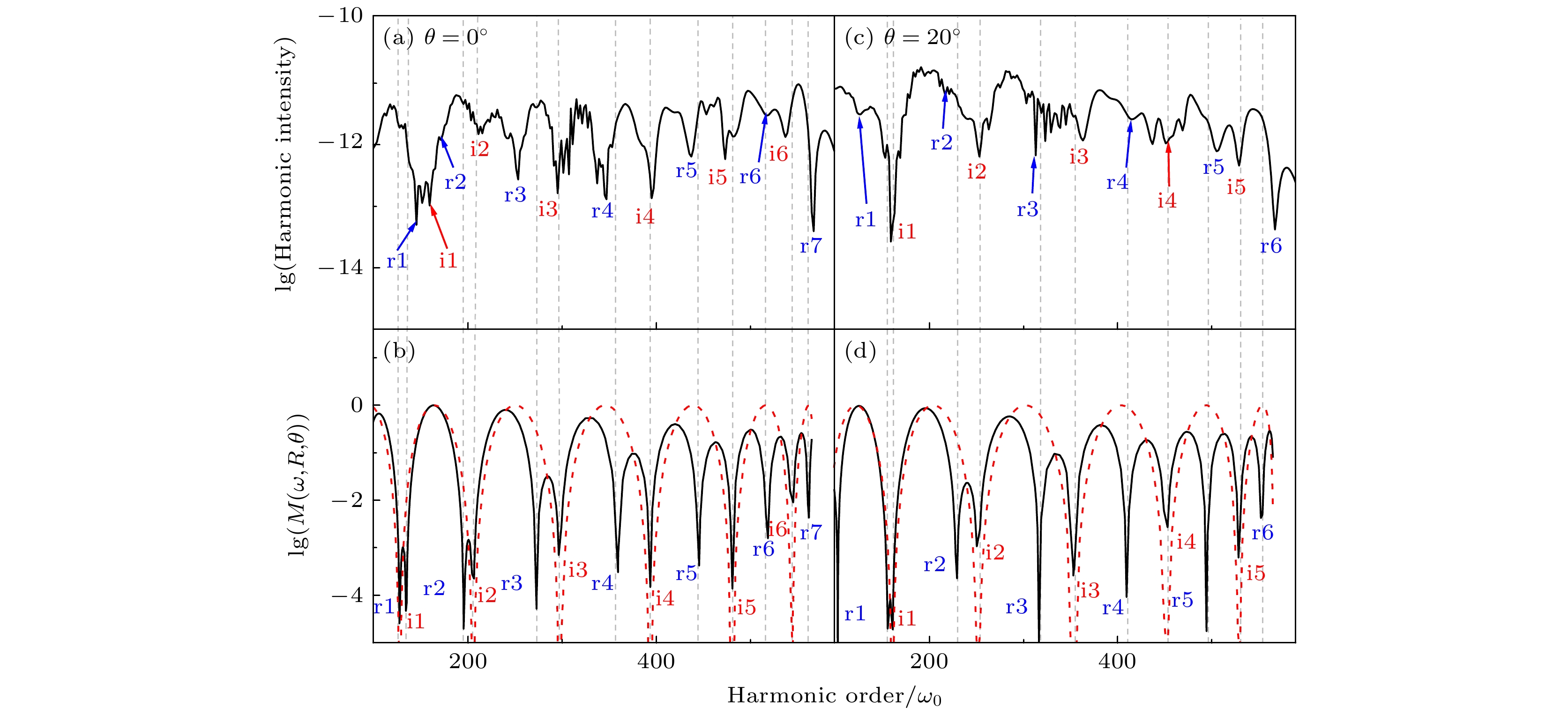

















 下载:
下载:
